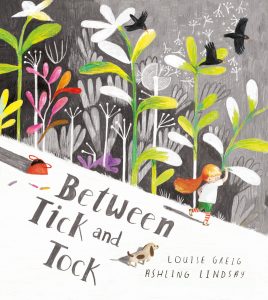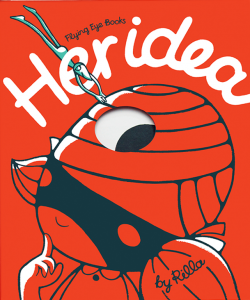 In a grey bustling city there is no time stop the roundabout to make friends, or notice a lost toy rolling under a park bench or help a stray dog or a stuck cat. But high in the rooftops where the birds roost, Liesel seems to stand outside of time and has the power to make the city pause for a moment. She uses this superpower to stop the clock between ticks and go paint a colourful mural, arrange an accidental encounter so that two children can become friends. She finds the toy and rescues the stray dog and generally intervenes to help people stop and take stock, to notice what’s going on around them. Between Tick and Tock is a meditation on how easy it is to get lost in the day to day and forget to marvel at the world. It raises philosophical questions on the nature of time.
In a grey bustling city there is no time stop the roundabout to make friends, or notice a lost toy rolling under a park bench or help a stray dog or a stuck cat. But high in the rooftops where the birds roost, Liesel seems to stand outside of time and has the power to make the city pause for a moment. She uses this superpower to stop the clock between ticks and go paint a colourful mural, arrange an accidental encounter so that two children can become friends. She finds the toy and rescues the stray dog and generally intervenes to help people stop and take stock, to notice what’s going on around them. Between Tick and Tock is a meditation on how easy it is to get lost in the day to day and forget to marvel at the world. It raises philosophical questions on the nature of time.
Is the flow of time just a human invention, something we just read on a clock?
Does it really exist?
Is time infinite? Or is there a beginning and an end to time?
What happens when the present moment becomes past?
Could it be possible to step outside of time?
Do we need time?
What does it mean to waste time?
How do you know you are in the present?
Do the past and the future exist?
Does time pass more quickly or slowly at depending on what you are doing?

 Sozi has an idea, in fact she has hundreds of ideas but they are slippery and illusive and when she comes to turn her ideas into reality she finds it’s not so easy. Then a passerby offers some hope. The passerby is a book which looks very much like the one that you are holding in your hands (more so if you remove the dust jacket). It helps capture her ideas and keep them safe until she is ready to do something with them.
Sozi has an idea, in fact she has hundreds of ideas but they are slippery and illusive and when she comes to turn her ideas into reality she finds it’s not so easy. Then a passerby offers some hope. The passerby is a book which looks very much like the one that you are holding in your hands (more so if you remove the dust jacket). It helps capture her ideas and keep them safe until she is ready to do something with them. Sam and Dave dig a hole next to an apple tree just outside a house. There is a cockerel weathervane on the roof and a red tulip in a pot balanced on the railing. A grey cat with a red collar watches. A dog joins Sam and Dave on their mission to dig until they find something spectacular. They dig and dig and each time they are on the brink of discovery they change direction and miss out. But something spectacular does happen and they land back where they started or do they? Sam and Dave seem unaware as they go inside for chocolate milk and animal biscuits that a few things are different.
Sam and Dave dig a hole next to an apple tree just outside a house. There is a cockerel weathervane on the roof and a red tulip in a pot balanced on the railing. A grey cat with a red collar watches. A dog joins Sam and Dave on their mission to dig until they find something spectacular. They dig and dig and each time they are on the brink of discovery they change direction and miss out. But something spectacular does happen and they land back where they started or do they? Sam and Dave seem unaware as they go inside for chocolate milk and animal biscuits that a few things are different.